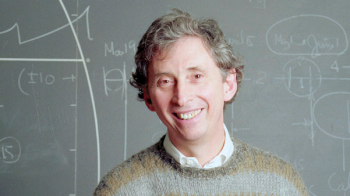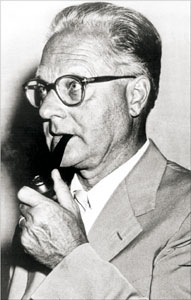
Edoardo Amaldi was a leading figure in Italian science in the 20th century, particularly in fundamental experimental physics. He contributed to nuclear physics in the 1930s and 1940s, and to cosmic rays and particle physics in the post-war years, then became a pioneer in the experimental search for gravitational waves in the 1970s. It is largely thanks to his drive that Italian physics emerged successfully from the slump following the Second World War. He was also one of the main players in the process that turned the dreams of large European scientific projects into reality, most notably CERN.
In Rome with Fermi
Amaldi was born in Carpaneto Piacentino, northern Italy, on 5 September 1908. He was the son of Ugo, a distinguished mathe-matician and university professor. Ugo’s academic career led him from Modena to Padua and finally to the University of Rome in 1924, where he joined the outstanding Italian mathematicians Vito Volterra, Tullio Levi-Civita, Guido Castelnuovo and Federigo Enriques. Edoardo enrolled at the University of Rome as a student of engineering in 1925. Two years later he moved to physics, attracted by the presence of Enrico Fermi, as were a few other brilliant students, including Emilio Segrè and Ettore Majorana. Amaldi took his degree in physics in July 1929, with a dissertation on the Raman spectrum of the benzene molecule. His thesis advisor was Franco Rasetti, who had moved from Florence to join Fermi in Rome. By the end of the 1920s a strong group of young physicists had become established at the institute in via Panisperna and their research efforts deliberately steered towards the new frontier of nuclear physics.
Under Fermi’s leadership, it became common practice to send young people abroad to stay for extended periods at leading research centres. In 1931 Amaldi spent 10 months in Peter Debye’s laboratory in Leipzig learning X-ray diffraction techniques in liquids. He later spent short periods at the Cavendish Laboratory at Cambridge, Columbia University and the Carnegie Institution.
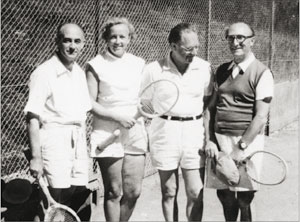
Image credit: Amaldi Archives, Dipartimento di Fisica, Universita ‘la Sapienza’ Rome, AIP Emilio Segrè Visual Archives.
Following the discovery by Frédéric Joliot and Irène Curie of radio activity induced by alpha particles, Fermi and his collaborators started a methodical search in March 1934, bombarding samples of different elements with neutrons emitted by a radon-beryllium source. Their experiments culminated in October 1934 with the discovery of the efficiency of slow neutrons in activating nuclear fission. The published papers carried the signatures of all team members (Fermi, Rasetti, Amaldi, Segrè, the chemist Oscar D’Agostino and, later, the young Bruno Pontecorvo). Fermi was clearly the intellectual leader and driving force, and for these results he would receive the Nobel Prize in Physics in 1938. In the meantime, Fermi and Amaldi did most of the work for the next few years following the discovery; Rasetti and Pontecorvo were mostly out of Rome and Segrè had moved to a professorship in Palermo. Amaldi thus acquired a competence in nuclear physics, particularly in the subject of neutron properties, that turned him into a leading authority in the field.
In 1937 Amaldi won a professorship at the University of Cagliari, but he was immediately called to the chair of experimental physics in Rome, which had been left vacant by the sudden death of Orso Mario Corbino. Amaldi kept this position until retirement. He continued to work on neutron physics with Fermi and Rasetti. They designed and built a Cockcroft–Walton accelerator, which was completed in 1939 at the Istituto Superiore di Sanità. By the late 1930s, however, the general situation in Italy was deteriorating rapidly. The lack of support necessary to keep research competitive, the alignment of fascism with Hitler’s Germany and the racial laws promulgated in 1938 led directly to the forced or voluntary emigration of many Italian physicists. When the Second World War began, Amaldi was the only member of the original Panisperna group still in the country.
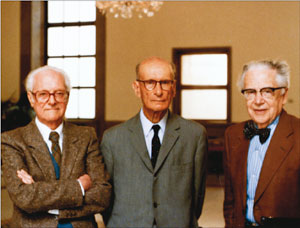
Image credit: AIP Emilio Segrè Visual Archives, Segrè Collection.
The war years
Left alone in Rome with a small group of younger researchers, Amaldi concentrated his research efforts on nuclear fission, working with physicists from the physics institute and the Istituto di Sanità, while Gian Carlo Wick replaced Fermi on the theory side. This work was interrupted when Amaldi was sent for a few months to the African front in 1940. On his return to Rome, research on fission continued. However, by 1941 suspicion arose that working on fission exposed the group to the risk of being recruited for war-related research. As a consequence, the experimental work shifted focus to the problem of proton–neutron scattering, while some of the younger graduates started research on cosmic rays.
Though research conditions were difficult during the war, Rome was still in a better situation than research facilities in northern Italy, especially after liberation in June 1944. By war’s end, most of what had been left of active research in Italy, in terms of both expertise and people, was concentrated in Rome. In collaboration with Wick and Gilberto Bernardini from Florence, Amaldi steadfastly took it upon himself to reconstruct Italian physics, starting from the vantage point offered by his location in the capital. The first move, completed successfully in October 1945, was to obtain from the reconstituted Consiglio Nazionale delle Ricerche (CNR) the establishment of a research centre for nuclear and elementary particle physics at the physics institute in Rome.
The years of reconstruction
During a trip to the US in 1946, Amaldi was offered a chair at the University of Chicago by none other than Fermi, but he declined because he felt a duty to take care of scientific development in his homeland. During the visit, Amaldi was confronted by the restrictions imposed on results and topics in “his” physics because of real or supposed military interest. He realized that, beyond a certain limit, it was impossible for him to talk freely even with Fermi about problems in nuclear physics. Amaldi found this disturbing on ethical grounds and detrimental to scientific progress. The experience strengthened his conviction acquired during the war years that genuine scientific collaboration is planned free from military control – a general policy to which he adhered strictly in the following years.
The scale of prestige acquired by nuclear and particle physics in the US after the war convinced Amaldi that the best course of action for Italian physics would be to concentrate on those research sectors where good results could be obtained with the modest means available. As a consequence, emphasis was placed on the relatively inexpensive research field of cosmic rays, where Italian physicists could rely on the solid tradition initiated by Bruno Rossi. The first step, in 1947, was to construct a high-altitude laboratory in the Italian Alps. New research centres followed: Padua in 1948, Turin in 1951 and Milan in 1952. Meanwhile, Amaldi promoted the development of applied nuclear research, training young engineers and physicists, and raising support among politicians – a programme that led to the construction of Italy’s first nuclear reactor.
Amaldi’s active role in the physics community and with politicians and administrators in Rome was decisive in winning a site close to Rome for the new laboratory.
Amaldi, Gustavo Colonnetti and Bernardini, relying on the strength of this active network and on the support of CNR’s president, were able to achieve a significant goal: the establishment in 1951 of the Istituto Nazionale di Fisica Nucleare (INFN). Bernardini was its first president and Amaldi took charge between March 1960 and January 1966.
The first important activity for INFN physicists was their participation in three international collaborations, which between 1952 and 1954 launched high-altitude balloons carrying photographic emulsions for the study of cosmic rays. Amaldi’s group in Rome took part in the first and second collaborations. Soon after, a more ambitious INFN programme was initiated for the construction of a competitive accelerator for high-energy physics. The project became reality in less than five years: the electron synchrotron of the Laboratori Nazionali in Frascati started operating in February 1959. Amaldi’s active role in the physics community and with politicians and administrators in Rome was decisive in winning a site close to Rome for the new laboratory. This was in line with a general scheme that assigned the development of nuclear facilities for civil purposes to the northern areas of the country and concentrated fundamental research at the nation’s capital.
Building European science
Soon after the war, physicists throughout Europe came to realize that only a collaborative effort between several countries could give Europe a competitive role in fundamental research. The proposal for a great European particle accelerator was put forward by Isidor Rabi in 1950, and Amaldi was one of the strongest advocates from the beginning. He took advantage of his capacity as vice-president of the International Union of Pure and Applied Physics to back the idea. The ambitious plan quickly took form using the institutional support of UNESCO. Amaldi and French physicist Pierre Auger, director of the scientific section of UNESCO, were the driving force for a project that was attractive to the younger generations of European physicists, but which had to overcome difficulties and opposition at both the scientific and the governmental levels.
By May 1951 a selected team of experts from eight countries approved a detailed plan, and by early 1952 an intergovernmental conference established a provisional organization, which took the name of the Conseil Européen pour la Recherche Nucléaire (CERN). Amaldi was elected general secretary of the provisional CERN and he supervised all of the crucial phases in the infancy of the new institution, including the early stages of work on the laboratory site, on grounds allocated by the city of Geneva. He left the position when CERN entered into official existence in September 1954, led – among other reasons – by the desire to revert to more active research work in physics. Paralleling the development of the laboratory in Frascati, the big CERN proton synchrotron was successfully completed in 1959, reaching a record energy of 28 GeV.
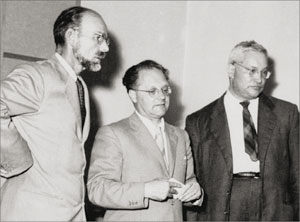
Amaldi always kept strong ties with CERN, maintaining a place in the scientific bodies that helped to shape its policy. In 1963 he created the European Committee for Future Accelerators, which was an independent body charged with planning new machines to be built in Europe (both at CERN and elsewhere), and he was president until 1969. He headed up the particular group that planned the new 300 GeV proton synchrotron for CERN in the late 1960s – a project approved by the member states in 1971, with Amaldi in charge as president of CERN Council. Simultaneously occupying important positions both at INFN and at CERN, Amaldi sometimes had to make delicate choices, balancing resources between domestic developments and international co-operation. This was evident when a decision had to be taken between launching a great effort for a new Italian proton synchrotron or giving Italy’s support to the project for the 300 GeV machine in Geneva. In this instance he was strongly in favour of the CERN project, convinced that priority in big science had to be granted to Europe.
In the early 1960s, when the project of a joint European effort in space was being discussed, a network of scientists and politicians similar to the one that had contributed to the success of CERN was formed, which included the French physicist Hubert Curien. Amaldi took an important role in launching the idea and pushing it through scientific and political circles. As a result, in 1964 the European Space Research Organisation was established, which later gave birth to the European Space Agency.
Research in cosmic rays and particle physics
In the time left over from academic and administrative duties, as well as acting as an organizer and planner of science, Amaldi stayed in active research, leading groups of young collaborators and moving his interest towards cosmic-ray physics. A high point came in the mid-1950s with work on one of the emulsions exposed to the cosmic radiation during the 1953 high-altitude balloon collaboration. The group found a track that could be interpreted as evidence of the annihilation of an antiproton – a particle the existence of which was taken for granted on a theoretical basis but that had not yet been observed. To gain better support for the evidence offered by the single track, Amaldi turned to Segrè at Berkeley, proposing a joint research programme aimed at the detection of similar events in emulsions exposed to the proton beam of the Bevatron. At the time this was the most powerful accelerator in the world and the only one that could reach an energy above the threshold needed to produce a proton–antiproton pair. The Rome–Berkeley collaboration lasted for a couple of years, yielding important results on antiprotons and their annihilation properties. However, the first confirmation of such a process – clearly visible in the emulsion tracks – came a few weeks after Segrè and his group had independently detected the antiproton by a different experiment that relied on counters instead of emulsions. For this discovery, Segrè and Chamberlain were awarded the Nobel Prize in Physics in 1959.
Amaldi’s interest in the experimental detection of gravitational waves began with a course on gravitational-wave antennas given by Joe Weber, the pioneer of this instrumentation, at Varenna in 1962. In 1970, under Amaldi’s leadership, a group formed in Rome with the aim of designing and building cryogenic detectors for gravitational waves. Initially, small-scale antennas were planned and put into operation; then larger detectors were built in succession in Rome, Frascati and at CERN – where the cryogenic antenna Explorer was installed in the 1980s, attaining by 1989 the highest sensitivity reached for many years. While leaving the direct responsibility to others, Amaldi played an active role throughout this period in both the planning and the execution of the experiments, as well as in recruiting young students to the field. The detection of gravitational waves is still an open problem almost 20 years after Amaldi’s passing. Huge facilities have been built for the purpose in large international collaborations, involving many Italian physicists – the legacy of a tradition borne out of Amaldi’s initial foresight.
In his mature years, Amaldi increasingly devoted part of his time to collecting his memoirs and putting on paper those moments in the history of physics that he had witnessed. He started with commemorations of friends and colleagues, then worked on recollections of important events. Amaldi’s reconstructions evolved into writings with growing insight into the more general historical context, with a care for sources and documentation not usually found in similar works by scientists. He was helped by a habit developed in his early days of keeping all relevant documentation related to his work and to the institutions that he was involved with. His personal archive helped him to produce works that went far beyond the traditional scientist’s recollection, resembling more the scope of scholarly research by an independent historian.
Working for peace and arms control
Amaldi’s concern for peace, and his strong feeling for the responsible role that the scientific community should play in this respect, was always a natural complement to his unshakable belief in the open nature of science and the need for international co-operation. By remaining in Italy during the war, he was spared the difficult decision about whether to take part in projects related to the military use of science. He later admitted that, had this been the case, he would in the end have put his competence to the service of what looked to him, beyond any doubt, the right side on which to fight.
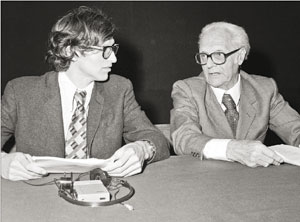
After the war he followed with interest the first attempts of American physicists to establish some sort of organization aimed at the control of the arms race. Following the 1955 Einstein–Russell appeal, Amaldi was involved in the Pugwash movement from the moment it was created in 1957 and became a member of the executive committee at the second Pugwash meeting in 1958, a position that he held until 1973. In 1966, with his physicist colleague Carlo Schaerf, he founded the International School on Disarmament and Research on Conflicts, which he chaired until his death.
In 1982 Amaldi led a delegation of Italian physicists to the president of the Italian Republic, presenting a resolution of concern with the ongoing arms race and the danger to Europe created by the deployment of cruise missiles. As a follow-up to this document, the Unione Scienziati Per Il Disarmo was founded – an active group that has since then kept the discussion on disarmament issues alive in Italy. One of Amaldi’s last public official speeches was in 1987, when he led a delegation of Italian scientists to the international forum in Moscow organized by the soviet leader Mikhail Gorbachev at a time when a new climate of liberation was opening up.
Amaldi was married to Ginestra Giovene, one of the few women among the physics students in Rome during the 1930s. They bore three children: Ugo, Francesco and Daniela. Ugo followed in his father’s steps as a high-energy physicist, leading to a career at CERN. Edoardo Amaldi was a member of a number of academies and learned societies and was the president of the Accademia dei Lincei, Italy’s national academy, between 1988 and 1989. It was at the end of a day’s work in his office at the Lincei, still in his full capacities, that a heart attack killed him in 1989, at the age of 81.







